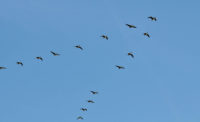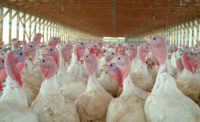The sensor uses a concept called waveguide interferometry to precisely determine how many virus particles attach to the sensor’s surface. Basically, two arms of an interferometer are coated with different antibodies. One arm, which serves as the sensing channel, is coated with antibodies specifically designed to capture the hemagglutinin protein located on the surface of the viral particle. The second arm is coated with non-specific antibodies and serves as a reference channel. When a liquid test sample passes over the waveguide, any antibody-antigen binding that occurs on the top of a sensing channel because of viral particle attachment causes water molecules to be displaced. This causes a relative change in the velocity of the light traveling through the sensing channel compared to the reference channel. By measuring this relative speed of light change based on the interferometry, the concentration of AI can be measured.
According to Jie Xu, research scientist and project director, GTRI’s prototype biosensor holds potential advantages over traditional AI identification methods. It is expected to be inexpensive, portable (so detection can be performed in the field), and is showing it should be able to detect several different avian strains simultaneously and within minutes. Recent experimental results using the prototype indicate it can detect H5 and H7 strains of AI at sensitivities fewer than 100 pfu virus particles in 1 milliliter of sample; in other words, well before symptoms of the virus would appear in infected birds.
“This has exciting implications for veterinary screeners and field service technicians who may be able to use it to keep isolated cases from spreading into epidemics,” says Xu.
To add to the sensor’s functionality, off-the-shelf components including a laser diode (similar to those used in DVD players) and a CCD detector chip (similar to those used in digital cameras) have been integrated into the design, explains Xu. The physical configuration of the biosensor box was also modified to accommodate user-friendly and field-usable operation. The box has a custom fixture for mounting the flow cell and sensor chip with hardware interfaces to ensure easy alignment with the optics. Xu believes this portable design should ultimately provide greater on-site analysis and control of avian influenza at the outset and during an outbreak, whether infection is on the farm, in live-bird markets, or in poultry processing facilities.
The research team next plans to validate the sensor’s detection capabilities experimentally with infected live chickens.
The study is being conducted in collaboration with Dr. David Suarez, the research leader of the Exotic and Emerging Avian Viral Diseases Unit at the Southeast Poultry Research Laboratory, and with Dr. Manoj Pastey, an assistant professor in the College of Veterinary Medicine at Oregon State University. Funding is being provided by the U.S. Department of Agriculture and the Georgia Research Alliance.
Reprinted from PoultryTech, a publication of the Agricultural Technology Research Program of the Georgia Tech Research Institute, a program conducted in cooperation with the Georgia Poultry Federation with funding from the Georgia Legislature.





